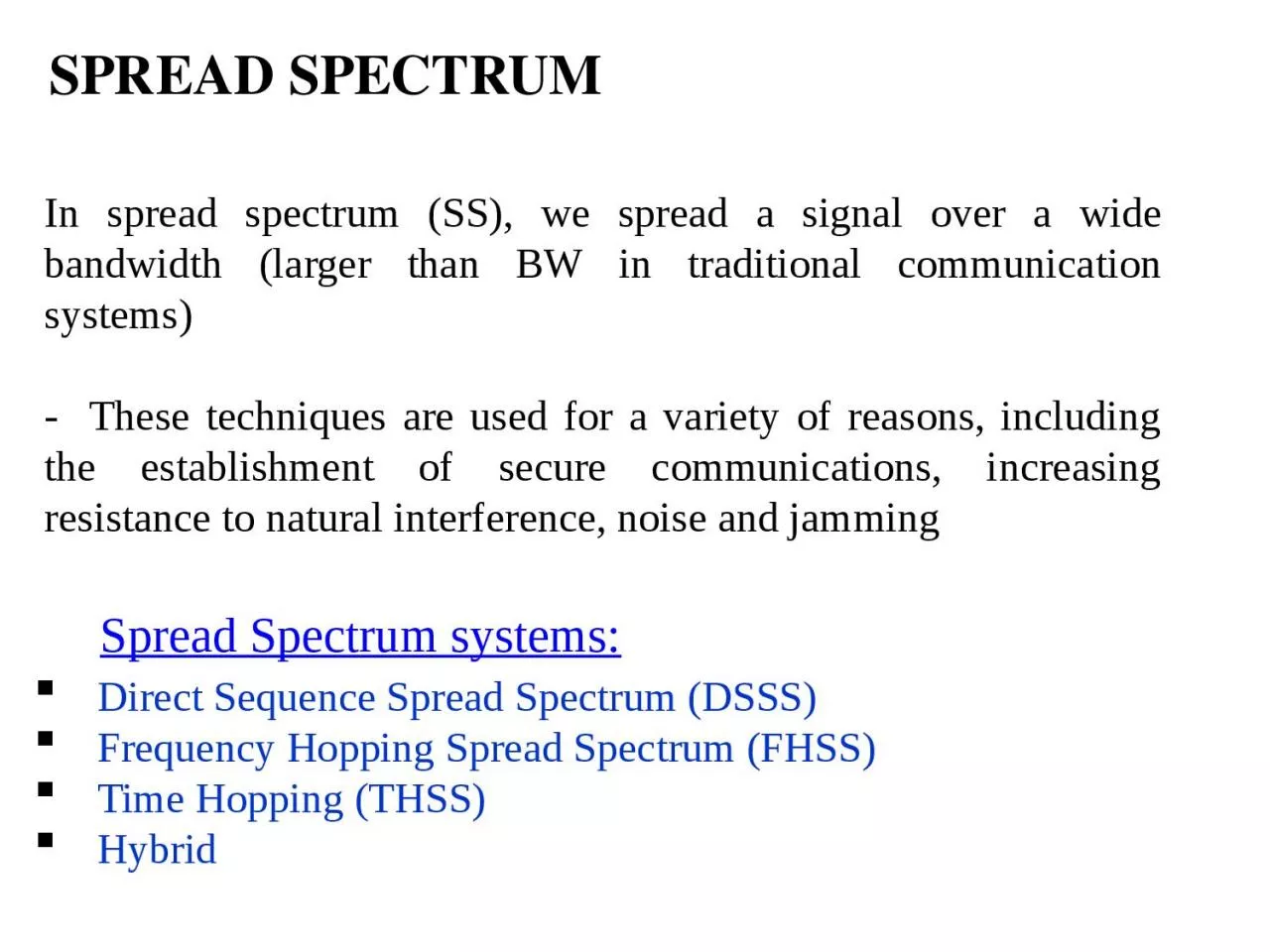

spread a signal over a wide bandwidth larger than BW in traditional communication systems These techniques are used for a variety of reasons including the establishment of secure communications increasing resistance to natural interference noise and jamming ID: 1031587
Download Presentation The PPT/PDF document "SPREAD SPECTRUM In spread spectrum (SS)..." is the property of its rightful owner. Permission is granted to download and print the materials on this web site for personal, non-commercial use only, and to display it on your personal computer provided you do not modify the materials and that you retain all copyright notices contained in the materials. By downloading content from our website, you accept the terms of this agreement.
1. SPREAD SPECTRUMIn spread spectrum (SS), we spread a signal over a wide bandwidth (larger than BW in traditional communication systems)- These techniques are used for a variety of reasons, including the establishment of secure communications, increasing resistance to natural interference, noise and jammingDirect Sequence Spread Spectrum (DSSS)Frequency Hopping Spread Spectrum (FHSS)Time Hopping (THSS)HybridSpread Spectrum systems:
2. Pseudo noise (PN) code is required in SS systemsPseudo noise (PN) code symbols are called chipsChip rate or PN code rate Rc >> Roriginal signal
3. Theoretical JustificationShannon and Hartely channel capacity theoremC=B log2(1+S/N)S/N is low for SS systems, so roughly C/B ≈ 1.433 * S/N or N/S ≈ B/CTo send error-free information for a given N/S in a channel, one need only perform the fundamental signal-spreading operation: increase B.Dr. Samah A. Mustafa
4. Direct Sequence Spread Spectrum DSSSDSSS phase-modulates the original signal with a continuous string of pseudonoise (PN) code symbols, each of which has a much shorter duration than an information bit.
5. DSSS example
6. General Model of Spread Spectrum System Receiver uses same sequence to demodulate signal
7. DSSS Example
8. DSSS ReceiverDSSS Transmitter
9. DSSS Using BPSK Example
10. RF bandwidth of DSSSPower distribution {(sinx)/x}2 …………..Null-to-null bandwidth is 2Rc90% of the power in the main-lobeOther modulations like QPSK , MFSK …………….Dr. Samah A. Mustafa
11. GainsImmunity from various noise and multipath distortionIncluding jammingCan hide/encrypt signalsOnly receiver who knows spreading code can retrieve signalSeveral users can share same higher bandwidth with little interferenceCellular telephonesCode division multiple access (CDMA)
12. Process Gain, typically 10-60 dB GPDr. Samah A. MustafaBenefits: Resistance to Interference and Anti-jamming Effects
13. More benefitsResistance to InterceptionResistance to FadingAddressingHigh resolution rangingMulti access technique CDMA Dr. Samah A. Mustafa
14. Code Division Multiple Access (CDMA)Multiplexing Technique used with spread spectrumIt plays a critical role in building efficient, robust, and secure radio communication systemsStart with data signal rate DCalled bit data rateBreak each bit into k chips according to fixed pattern specific to each userUser’s codeNew channel has chip data rate kD chips per secondE.g. k=6, three users (A,B,C) communicating with base receiver RCode for A = <1,-1,-1,1,-1,1>Code for B = <1,1,-1,-1,1,1>Code for C = <1,1,-1,1,1,-1>
15. CDMA Example
16. CDMA ExplanationConsider A communicating with baseBase knows A’s codeAssume communication already synchronizedA wants to send a 1Send chip pattern <1,-1,-1,1,-1,1>A’s codeA wants to send 0Send chip[ pattern <-1,1,1,-1,1,-1>Complement of A’s codeDecoder ignores other sources when using A’s code to decodeOrthogonal codes
17. CDMA for DSSSn users each using different orthogonal PN sequenceModulate each users data streamUsing BPSKMultiply by spreading code of user
18. CDMA in a DSSS Environment
19. Frequency Hopping Spread Spectrum (FHSS)Signal broadcast over series of frequenciesReceiver hops between frequencies in sync with transmitterEavesdroppers hear unintelligible blipsJamming on one frequency affects only a few bits
20. Basic OperationTypically 2k carriers frequencies forming 2k channelsChannel spacing corresponds with bandwidth of inputEach channel used for fixed intervalEx. 300 ms in IEEE 802.11
21. Frequency Hopping Example
22. Frequency hopping spread spectrum (FHSS)
23. Frequency selection in FHSS
24. FHSS cycles
25. Bandwidth sharing